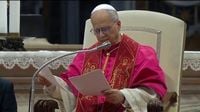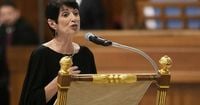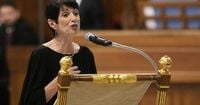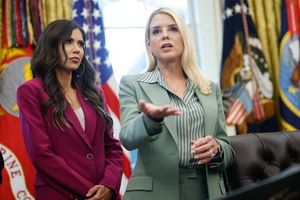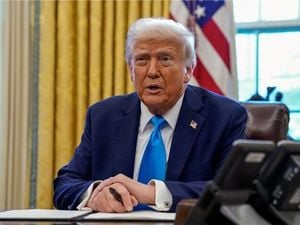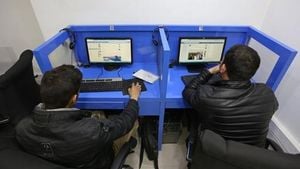On Monday, September 15, 2025, the hushed grandeur of St. Peter’s Basilica in Rome was pierced by a story of unimaginable loss and remarkable forgiveness. Diane Foley, the mother of slain American journalist James Foley, stood before a Vatican vigil and recounted her journey from heartbreak and anger to grace and healing—a journey that drew the attention and praise of Pope Leo XIV, history’s first American pope.
The vigil, held on the eve of a Holy Year event honoring all those who suffer, became a stage not just for mourning, but for hope. James Foley’s name is seared into the public consciousness: a courageous journalist who, along with other Western reporters and aid workers, was kidnapped and ultimately killed by a group of British-born Islamic State militants in Syria during their notorious reign of terror. These militants, chillingly dubbed “the Beatles” for their accents, released a grisly video of Foley’s beheading in 2014, claiming it was retribution for U.S. airstrikes in Iraq. The footage shocked the world and left the Foley family—like so many others—reeling in grief.
According to The Associated Press and Reuters, Diane Foley’s appearance at the Vatican was more than a remembrance; it was a testament to the power of forgiveness. She described, in vivid detail, the emotional aftermath of her son’s murder. “I staggered under the weight of that loss, unsure if I could go on,” Foley admitted, her voice breaking as she clutched her hand to her chest. “In those dark moments I prayed desperately for the grace not to become bitter, but to be forgiving and merciful.”
Her prayers were tested in ways few could imagine. In 2024, Foley published a book chronicling her face-to-face meetings with Alexanda Kotey, one of the British-born Islamic State militants convicted in connection with her son’s kidnapping and murder. These encounters, she revealed from the altar of St. Peter’s, were transformative. “The Holy Spirit allowed us both to listen to each other, to cry, to share our stories. Alexanda expressed much remorse. God gave me the grace to see him as a fellow sinner in need of mercy, like me,” she said. Foley described these meetings as “moments of grace”—a phrase that resonated throughout the basilica.
The Pope, deeply moved by Foley’s testimony, responded with words that echoed through the marble halls. “The testimonies we have heard speak of a truth: that pain must not give rise to violence and that violence never has the final say, for it is conquered by a love that knows how to forgive,” Pope Leo XIV declared. “What greater freedom can we hope to achieve than that which comes from forgiveness?”
James Foley’s story, while singular in its heartbreak, is emblematic of the suffering endured by many at the hands of the Islamic State group. The militants—led by the infamous Mohammed Emwazi, known as “Jihadi John”—targeted Westerners in a campaign of terror that drew international condemnation. Foley’s murder in 2014, at the age of 40, marked a grim turning point. The video of his beheading became a symbol of the group’s brutality and the dangers faced by journalists in conflict zones.
The quest for justice was long and fraught with obstacles. Nearly four years after Foley’s death, Alexanda Kotey and his co-defendant, El Shafee Elsheikh, were captured by a Kurdish-led, U.S.-backed militia in Syria. The actual executioner, Emwazi, was killed by an American drone strike, eliminating the man most directly responsible for Foley’s murder. Kotey and Elsheikh, after extensive legal wrangling, were eventually brought to the United States for prosecution in 2020. The U.S. Justice Department agreed to forgo the death penalty as a condition for extradition, a decision that underscored the complexities of international justice in terrorism cases.
Kotey ultimately pleaded guilty to multiple offenses related to the abduction, torture, and killing of ISIS hostages in Syria, including James Foley. He was sentenced to life in prison—a verdict that, while offering some measure of closure, could never erase the pain felt by the Foley family and other victims’ loved ones.
Yet, as Diane Foley’s story illustrates, closure is not always synonymous with justice. Sometimes, it’s found in the most unexpected places—in a prison meeting room, in a shared moment of vulnerability, or in the act of seeing one’s enemy as a fellow human being. Foley’s willingness to meet with Kotey, to listen and to forgive, is a testament to the resilience of the human spirit. “The holy spirit allowed us both to listen to each other, to cry, to share our stories. Alexanda expressed much remorse. God gave me the grace to see him as a fellow sinner in need of mercy, like me,” Foley repeated, her words underscoring the theme of the evening.
Pope Leo XIV, who has made compassion and reconciliation hallmarks of his papacy, seized on the moment to reinforce his message that forgiveness is not weakness, but strength. “Pain must not give rise to violence and that violence never has the final say, for it is conquered by a love that knows how to forgive,” he reiterated, urging the world to look beyond cycles of retribution.
The vigil itself was part of a larger Holy Year event, designed to honor those who suffer—whether from war, violence, or personal tragedy. Foley’s story, while deeply personal, served as a beacon for others grappling with their own losses. Her journey from anger to forgiveness, from despair to hope, offered a model of healing that transcends religious boundaries.
As the evening drew to a close, the basilica’s ancient stones seemed to absorb the weight of what had been shared. There were no easy answers, no simple paths to peace. But in the quiet aftermath, the words of Diane Foley and Pope Leo XIV lingered—a reminder that even in the darkest moments, forgiveness remains possible. And in that possibility lies a freedom that violence can never claim.
